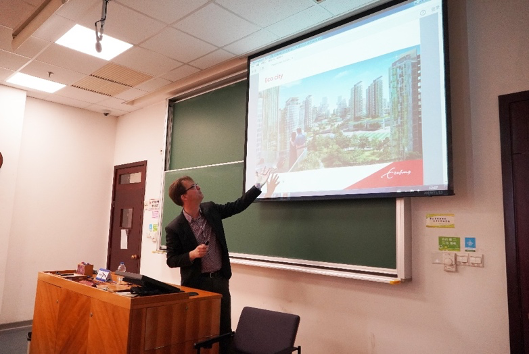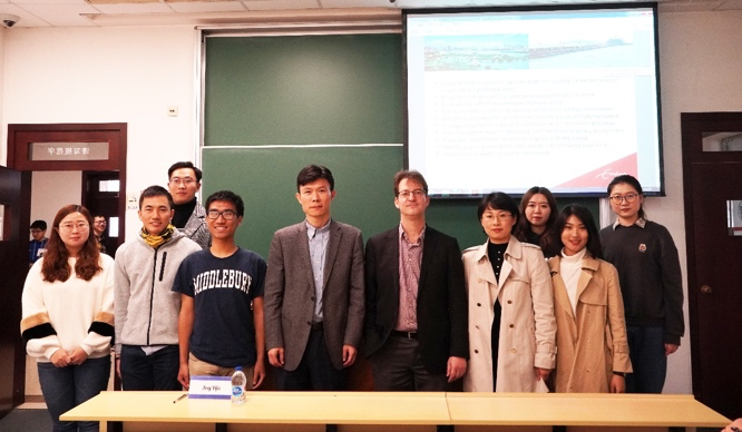Events



On 13th November 2019, the Institute for Global Public Policy (IGPP) held the 20th event of the Fudan-LSE Lecture Series in Room 302, West Sub Building of Guanghua Tower at Fudan University. Martin de Jong, professor at Erasmus University Rotterdam in the Netherlands and visiting professor at IGPP at Fudan University, delivered the lecture “From City Branding to Policy Implementation: How to Avoid Green-Washing and Trigger Deep Urban Transformation”. Professor Yijia Jing, dean of IGPP, chaired the lecture.
The lecture started with a brief introduction of Professor Martin de Jong. Professor Martin de Jong is a full professor at Rotterdam School of Management and Erasmus School of Law, both at Erasmus University Rotterdam. He is the scientific director of the Erasmus Research Initiative for the Dynamics of Inclusive Prosperity at Erasmus University Rotterdam. He is also a senior expert of the State Administration of Foreign Experts Affairs. His research interests cover governance policy, planning, and decision-making in China, transportation infrastructure, sustainable city development, city branding, corporate social responsibility, and cross-cultural communication.
Professor Martin de Rong shared his story about China and Fudan University. Talking about Harbin, the first city he first visited in China, and his investigation and experience of eco-city planning and development in China in the past decade, he introduced the topic of this lecture – city branding and policy implementation. He pointed out that the past decade has seen a dramatic surge in the use of city branding practices by local governments around the world. Chinese cities, especially in the more developed east of the country, are no exception. They have sometimes formulated sophisticated images of themselves: city brand identities. They have also stepped up their use of a great variety of attractive city labels, such as eco-cities, low carbon cities, smart cities, knowledge cities, and resilient cities. These concepts reflect the desired shift from old and polluting manufacturing industries to new and clean service industries. Professor Martin de Jong then focused on what these city branding efforts look like in actual policy practice and how the implementation of such strategies can contribute to more sustainable urbanism.

Professor Martin de Jong then discussed about the definition of eco-city by Richard Register and Peter Newman. Register believes eco-cities are about pedestrians, bicycles, and trains. Even there are many high-rise buildings with elevators, there should also be many green roofs, corridors, and open spaces. City building should fit the original topography and builds parks and greeneries as much as they can. Newman argues that city form has determined mobility and resource consumption. Cities will be sustainable when they function like ecosystems. Professor Martin de Jong took eco-cities around the world as examples to introduce eco-city theory. He also mentioned the early practice of building eco-cities in China—Wanzhuang in Langfang, Hebei province, and the Chongming Eco-Island, which is under planning.
Professor Martin de Jong took city branding as a public policy. He mentioned many countries have devoted huge efforts to transfer knowledge and demonstration programs from foreign countries for city branding. Many cities around the world have achieved success. However, most of them have only developed an indicator system, and only a few eco-cities have conducted environmental measurement and monitoring. He took two Chinese cities, Xiamen and Qingdao, as examples to analyze how factors, including environment, government support, positive evaluation, idealism, fashion, and city reputation and city branding, may influence the popularity of eco-cities.
Professor Martin de Jong then compared those emerging terms, such as knowledge city, smart city, smart growth, and ecological modernization, with the original concept of the eco-city by using statistical data and charts. He explained their connections and difference and analyzed the future development trend. He selected cases such as Qatar, the United Arab Emirates, and Abu Dhabi to illustrate how different cities establish their brands and concluded some features of city branding, including attracting investors, industries, and tourists; oriented to the private sector market; showing multiple aspects of the city; fostering loyalty; reflecting the past, present and future and ambitious, realistic and unique. He stated that the city brand should be developed in cooperation with stakeholders. Adding symbols, slogans, buildings, infrastructure, iconic events may contribute to city branding. Professor Martin de Jong pointed out that city branding could be divided into three levels: characteristics, positioning or label, and impression. He further took China’s three major metropolitan areas as examples to analysis the status quo of city branding in China.
Professor Martin de Jong then concluded the lecture. He believed that city branding is an important entry point to realize ecological modernization, and among which smart city is the key. The promotion of city branding needs to be transformed into an implementing strategy. The development approach to connect municipal agency planning and brand, with the support of policy tools, is essential in making breakthroughs. Based on these premises, city characteristics, policy behaviors and public images may gradually converge, and ultimately protect the uniqueness of each city.

In the end, professor Martin de Jong had a heated discussion with the audience and took a group photo with all the audience at present.